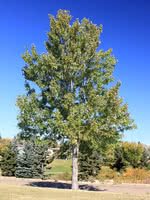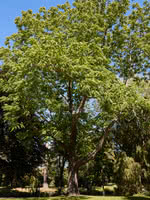Mon-Fri 9am - 5pm Mountain time
Silver Maple vs Black Walnut
Acer saccharinum
Juglans nigra
Silver Maple is a fast-growing, large deciduous tree that typically has a short trunk and sharply branched crown.
Silver Maple bears red flowers in early spring and beautiful five lobed, deeply notched green and silver leaves that turn yellow in the fall. This versatile and attractive shade tree requires a large yard.
Silver Maple is often used to make syrup instead of Sugar Maple in colder areas where Sugar Maple sap does not sweeten very well (like the Canadian prairies).
The Black Walnut is a slow growing, large, straight-stemmed tree with an open crown. It produces dense, very hard, edible nuts.
Black Walnut has a deeply-furrowed, black bark. Its leaves are about 1 foot long, composed of 15 - 23 slightly stalked leaflets on a moderately stout stock which provide good dappled shade.
Despite being highly valued for its edible nuts and its shade tree aesthetics, it is rare to see this tree on the prairies.
Note: Black Walnut's roots produce a substance named juglone that is toxic to some other plants. Consider this when choosing where you plant a black walnut, as you will not be able to grow tomato, potato, cabbage, eggplant, blueberry, azalea, rhododendron, lilac, red pine and apple in the surrounding area.
Note: Plant this tree once. It will not respond well to transplanting.
Note: Although self-pollinating, planting two trees significantly improves nut production.
A top CO2 absorbing species. Experts think this tree may help climate change more than others.

